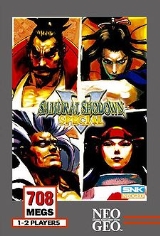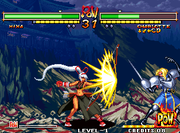
Samurai Shodown V Special
Encyclopedia
Samurai Shodown V Special, known as in Japan, is the ninth game in SNK
's Samurai Shodown/Samurai Spirits series of fighting games. This game is an upgraded version of the game titled Samurai Shodown V, and is the last official game for the Neo Geo
platform. A further upgraded version of the game, Samurai Shodown V Special: Final Edition, was location tested, but never officially released.
 The core gameplay remained relatively the same from Samurai Shodown V
The core gameplay remained relatively the same from Samurai Shodown V
, but there were all new graphics, including portraits done by artist Satoshi Ito, which conveys a dark atmosphere similar to that of Samurai Shodown III
A significant amount of changes were made between Samurai Shodown V and Samurai Shodown V Special. Among them, the midboss characters Sankuro and Yumeji were taken out and replaced with SS1 boss Amakusa Shiro Tokisada and SS3 boss Zankuro Minazuki. While hidden character Poppy was replaced with SS2 boss Rashoujin Mizuki, playable without needing a hidden code.
In addition to the roster change, many graphical and sound changes were done to give the game a fresh feel, even though most of the returning characters used their old voices dating all the way back to Samurai Shodown IV. Existing SS5 character stages were modified in one way or another, and new stages were presented for the arrival of Amakusa, Zankuro, and Mizuki. Mizuki's stage was all new.
This game also has many gameplay tweaks, making this version much more balanced than its predecessor. The biggest gameplay change, however, was the introduction of the Zetsumei Ougi, or the Overkill move for English-speaking areas. If this move was performed properly, it would instantly end the match for its victim, regardless of how much life he or she had remaining, a concept similar to that of the Guilty Gear series, except the conditions to execute the move were more strict, as your character had to be in a rage explosion while the opponent's life is below the point they could or could've entered Concentration One, which was introduced in Samurai Shodown V as a special slow motion mode they could power up by meditating. (Holding D while standing still) The start up motion is the same for each character when you attempt it, but if it were to hit, the attacking character would finish off their victim in their own unique fashion.
In addition to the overkill moves, generic fatality effects from Samurai Shodown IV were brought back for this game, such as being slashed in half in a horizontal fashion. New fatality effects were also introduced, such as being split in half vertically with the splitting victim drenching their opponent with their blood as in Samurai Shodown IV. In addition, Nakoruru and Rimururu, who both were made "immune" to fatality effects in SS3 and 4, were able to experience these fatality effects at the end of a match as well, and in some situations lead to them screaming violently.
This combination of violent acts represented in Samurai Shodown V Special generated a lot of controversy. This led to SNKP censoring the Neo Geo
AES cartridge shortly after the Sasebo slashing.
Upon hearing fan outcry, SNK did a cart recall shortly after that which fixed the bugs brought about by the censoring acts, and also to restore the character specific zetsumei ougis, but only partially. The acts of body splitting were still long gone, which made some of the zetsumei ougis make no sense. However, some of the more violent content still remained, such as the more violent death screams and being able to be smashed into a wall.
The only way for players outside of an arcade to experience the zetsumei ougis was either through emulation or to get an unfixed version of the game and apply Razoola's Universe Bios to it, which allows access to the uncensored versions of the moves and fixes the bugs that the censorship created.
SNK Playmore
SNK Playmore Corporation is a Japanese video game hardware and software company. SNK is an acronym of , which was SNK's original name. The company's legal and trading name became SNK in 1986....
's Samurai Shodown/Samurai Spirits series of fighting games. This game is an upgraded version of the game titled Samurai Shodown V, and is the last official game for the Neo Geo
Neo Geo (console)
The is a cartridge-based arcade and home video game system released on July 1, 1991 by Japanese game company SNK. Being in the Fourth generation of Gaming, it was the first console in the former Neo Geo family, which only lived through the 1990s...
platform. A further upgraded version of the game, Samurai Shodown V Special: Final Edition, was location tested, but never officially released.
Gameplay

Samurai Shodown V
Samurai Shodown V, known as in Japan, is the eighth game in SNK's Samurai Shodown/Samurai Spirits series of fighting games. It was one of the last ever games to be released on the Neo Geo. The original Japanese version of the game also has a great deal of dialogue in single-player mode, but all...
, but there were all new graphics, including portraits done by artist Satoshi Ito, which conveys a dark atmosphere similar to that of Samurai Shodown III
Samurai Shodown III
Samurai Shodown III: Blades of Blood, known as in Japan and Fighters Swords in Korea, is the third game in SNK's popular Samurai Shodown series of fighting games for the Neo Geo...
A significant amount of changes were made between Samurai Shodown V and Samurai Shodown V Special. Among them, the midboss characters Sankuro and Yumeji were taken out and replaced with SS1 boss Amakusa Shiro Tokisada and SS3 boss Zankuro Minazuki. While hidden character Poppy was replaced with SS2 boss Rashoujin Mizuki, playable without needing a hidden code.
In addition to the roster change, many graphical and sound changes were done to give the game a fresh feel, even though most of the returning characters used their old voices dating all the way back to Samurai Shodown IV. Existing SS5 character stages were modified in one way or another, and new stages were presented for the arrival of Amakusa, Zankuro, and Mizuki. Mizuki's stage was all new.
This game also has many gameplay tweaks, making this version much more balanced than its predecessor. The biggest gameplay change, however, was the introduction of the Zetsumei Ougi, or the Overkill move for English-speaking areas. If this move was performed properly, it would instantly end the match for its victim, regardless of how much life he or she had remaining, a concept similar to that of the Guilty Gear series, except the conditions to execute the move were more strict, as your character had to be in a rage explosion while the opponent's life is below the point they could or could've entered Concentration One, which was introduced in Samurai Shodown V as a special slow motion mode they could power up by meditating. (Holding D while standing still) The start up motion is the same for each character when you attempt it, but if it were to hit, the attacking character would finish off their victim in their own unique fashion.
In addition to the overkill moves, generic fatality effects from Samurai Shodown IV were brought back for this game, such as being slashed in half in a horizontal fashion. New fatality effects were also introduced, such as being split in half vertically with the splitting victim drenching their opponent with their blood as in Samurai Shodown IV. In addition, Nakoruru and Rimururu, who both were made "immune" to fatality effects in SS3 and 4, were able to experience these fatality effects at the end of a match as well, and in some situations lead to them screaming violently.
This combination of violent acts represented in Samurai Shodown V Special generated a lot of controversy. This led to SNKP censoring the Neo Geo
Neo Geo (console)
The is a cartridge-based arcade and home video game system released on July 1, 1991 by Japanese game company SNK. Being in the Fourth generation of Gaming, it was the first console in the former Neo Geo family, which only lived through the 1990s...
AES cartridge shortly after the Sasebo slashing.
Censorship
As the AES version of the game was approaching its release date on July 8, 2004, it was mysteriously delayed a week, moving its release date to the 15th. When it came out, the whole Neo Geo community was shocked to see that not only were generic fatalities removed, but the zetsumei ougi was watered down to a loosely based version of the issen for the characters. As a first, this act of censorship affected the entire worldwide release, not just the non Japanese speaking audience. Not only did these modifications censor the game, but the censorship also created bugs, such as that of the AES's exclusive training mode.Upon hearing fan outcry, SNK did a cart recall shortly after that which fixed the bugs brought about by the censoring acts, and also to restore the character specific zetsumei ougis, but only partially. The acts of body splitting were still long gone, which made some of the zetsumei ougis make no sense. However, some of the more violent content still remained, such as the more violent death screams and being able to be smashed into a wall.
The only way for players outside of an arcade to experience the zetsumei ougis was either through emulation or to get an unfixed version of the game and apply Razoola's Universe Bios to it, which allows access to the uncensored versions of the moves and fixes the bugs that the censorship created.

